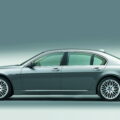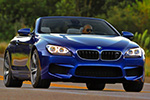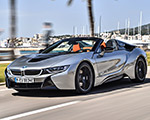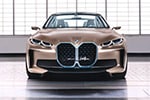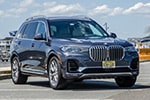About 15 years ago, BMW started catching flak from loyal enthusiasts about the brand slapping its “M” badges on cars that weren’t proper M cars. “‘M’ stands for ‘marketing’ now, not motorsport,” they’d cry. While that always seemed whiny, I feel like it’s my turn to whine. But after testing the new 2025 BMW X3 M50, I don’t think M is for marketing; I think it stands for mainstream.
Everything about the X3 M50 seems sanitized, stripped of character and charm, all in an effort to attract as many buyers as absolutely possible. Its generic SUV looks, an interior that looks like it came from a teenager’s mood board, and the most uninteresting driving experience from anything wearing a Roundel all combine to make the X3 M50 the most vanilla BMW I’ve ever experienced. BMW even dropped the “i” at the end of M50. I know that isn’t news for BMW fans, but this was the first such Bimmer I’ve tested, and it feels like losing a cool little detail that harkened back to BMW’s history. I know why BMW dropped it, as it’s mostly meaningless now and customers are getting it confused with electric “i” models, but it feels like losing a piece of BMW’s soul. Fitting for this car, then.
An Inoffensive but Ultimately Boring Design
I admittedly hated the new X3 when BMW first unveiled it. But after spending a week with it, it grew on me. I still don’t love it; it’s painfully boring, has far too many slab-like panels, its headlights look like they were designed on a napkin at lunch, and it’s completely devoid of character. However, at least in M50 guise and wearing Vegas Red Metallic paint, it began to look just like a generic quick SUV to me, rather than something offensive. That said, my neighbor has a 2024 BMW X3 M40i and it proves how far this new X3 has fallen.
2025 BMW X3 M50
Good
- Smooth, powerful B58 inline-six engine with strong highway passing power
- Comfortable, composed ride quality even in sport mode
- Solid build quality with high-end materials and sturdy fitment
Bad
- Lacks steering and chassis engagement compared to past BMWs
- Interior design feels flashy and juvenile, with questionable ergonomics
- Muted exhaust note and excessive synthetic engine sound in the cabin
Typically, when I test a mid-fast premium crossover, I hear cynical criticism from enthusiast friends but praise from everyone else. Americans love their go-kinda-fast SUVs. But few people even cared about this new X3. I heard a few negative comments, but otherwise the silence was deafening.
That’s not to say there aren’t some redeeming qualities. For example, the kidney grilles are at least kind of normal (a triumph for any modern BMW), I like the iX-inspired hood design, and its overall profile is handsome enough, even if its front end is too tall. I just feel like it’s going to be lost in the sea of other premium crossovers and flat-out get left behind by great looking ones from, Acura, Volvo, and even upcoming newbies like the Rivian R2. I also had a chance to test some of them recently and it shows how far this segment has grown in quality.
Who Is This Interior For?
I’ve owned and driven BMWs from several different decades. All of them have had one thing in common, when it comes to their interiors: maturity. BMW’s have always had serious interiors, perhaps overly so sometimes, designed with well thought out ergonomics, mostly good build quality (my E36 was made out of tissue paper), and emphasis on visibility and usability. This new X3, though, looks like it was designed for teenagers, by teenagers. The massive center console V-shaped light bar looks silly and just takes up space, the A-pillars are thick and in the way, and BMW’s incessant use of hidden air vents with annoying little directional control toggles is frustrating.
However, the most egregious interior error is the entire door pull area. The X3’s interior door pulls are little triangular jobs that are built into a console that also houses the memory seat buttons, a touch-based air vent slider, an exposed air vent (why are these exposed but the dash vents aren’t?), and another bulky V-shaped light bar that takes up too much space. It’s just far too cluttered, bulky, unsightly, and annoying to use.
I will say I like the cubby just ahead of the center console, though. It has a vertical wireless phone charger—which charges shockingly quickly—and a big cubby for stuff like my wallet, keys, and earbuds. And the rubberized, ribbed nature of the panel kept my phone from getting too hot while charging, which is always a problem, while also holding my things in place. It looks cool and it works well.
In terms of build quality, BMW continues to make top-notch interiors, as it felt solidly built. Everything feels sturdy inside the X3, like it’ll last many years without nary a squeak or rattle. Shut the doors and the close with a high-quality whoomph. And I really like how easily the rear cargo cover snaps in and out of place. It’s as well-made as you’d expect from a BMW cabin but it looks like it was designed by a 16-year-old, both it terms of unnecessary flashiness and wonky ergonomics. I’m not sure if BMW’s target demographic has changed but I’m not sure who it expects to buy this car.
Bigger Outside but Bigger Inside?
When you see the new BMW X3 M50 from the outside, you expect a ton of increased interior space, versus its predecessor. However, that’s only true in the trunk, where its 31.5 cubic-feet of cargo space bests the old X3’s 28.7 cubic-feet. The previous-gen X3 actually has almost an inch of extra front headroom, while front leg and shoulder room are about the same. The old car’s nearly inch of extra headroom extends to rear passengers, too. While rear leg room is about the same on both cars, the new one does have about an inch of increased rear shoulder room.
To remedy the reduction of headspace, BMW gave the new X3 an optional full glass roof. That brings loads of light into the cabin, making it feel airier, but it doesn’t move so you can’t open the sunroof.
While the new interior isn’t worse than the old one, it certainly isn’t the big upgrade that its exterior mass seems to suggest.
Drives for Mass-Market Appeal
I couldn’t help but think, after a week of driving the BMW X3 M50 in every sort of realistic scenario, that it would make a great Mercedes. The steering is light and mostly vague but has decent on-center feel, the ride is beautiful, and it’s rock-solid stable at high speed. But turn the wheel with any sort of enthusiasm and it fails to reward. I distinctly remember testing the previous-generation X3 M40i for the first time and I knew it was a great car within 30 feet. I could just tell that its steering and ride were tuned by people who care about driving. But this one? It feels like it was designed for mass-market appeal.
Don’t think that means it’s sloppy. It isn’t. It’s quite a capable machine, even through some of southern New Jersey’s twistier bits of road. Once its weight subtly transfers, it grips and goes. But it just never gives you the sense that it’s particularly interested in doing so. Few modern BMWs talk to you through the steering anymore, that mostly died after the E90. But most modern Bimmers still talk to you through the chassis; you can feel what they’re doing through your ass in the seat. Not this one, though. You can tell it’s capable and that it’s doing its job, but only by the results. It tells you nothing through any of the controls.
I also disliked the brake pedal. Not the brakes themselves. They work beautifully, actually, with near perfect pedal feel and tuning. However, the brake pedal itself is positioned way to high, so I had to flex my right foot upward to reach it and it was just uncomfortable and annoying.
The ride is wonderful, though. It’s supple and rounds out bumps beautifully, while always maintaining its composure. Even in its sport mode, its ride never gets less comfy. It’s one of the most buttoned down, solid feeling crossovers of its size that I’ve ever driven.
What Did They Do to My Boy?
BMW’s B58 engine is one of my favorite engines of all time. My effusive praise for the 3.0-liter turbocharged straight-six over the years has likely been nauseating for anyone reading my words. I’ve loved it in every single application, BMW or otherwise. And, as an engine, it works brilliantly in the X3 M50. It’s as smooth as ever and provides plenty of performance. I was admittedly a touch disappointed at the lack of punch it seemed to have, but that’s likely due to the SUV’s 4,535-pound curb weight and BMW’s decision to isolate occupants from as much feeling as possible.
However, BMW absolutely neutered the B58’s noise. I’m not sure whether there’s some emissions reason, or if BMW just forgot to tune the exhaust, but the X3 M50’s exhaust note is pretty bad. It’s tinny and coarse on startup and just sounds… generic when revving from the outside. On the inside, the cabin is so quiet you barely hear the I6’s real voice. Instead, you hear the synthetic soundtrack pumped in by BMW’s sound engineers and it sounds less than stellar, to be kind.
In every other application, the B58 sounds glorious. The Toyota Supra and BMW Z4 M40i are its best examples, where it sounds like an exotic car engine. But in the X3 M50, it’s robbed of its character, which is wildly disappointing.
With 393 horsepower and 428 lb-ft of torque, the X3 M50 is one of the most powerful B58-powered cars ever, so it’s no surprise BMW claims it can hit 60 mph in 4.4 seconds. That’s quick for a family SUV but it never really feels it from behind the wheel. It does have plenty of passing power once you’re at highway speeds, though, it just seems to struggle with getting off the line with gusto. Or perhaps just the lack of sensation, audible or otherwise.
Most Customers Will Love It, Enthusiasts Won’t
Everything about the new 2025 BMW X3 M50 feels like it was designed for mass market appeal. That shouldn’t come as too much of a surprise, given BMW’s pretty steady movement in that direction for years. However, this new X3 feels like the pinnacle of BMW’s transition.
This new X3 is a good car; it’s comfortable, quiet, spacious enough, and packed with great tech. Sure, it might not be very interesting to look at, and its interior is a bit childish, but it makes for an excellent everyday car. However, I also feel like it’s the least BMW-like Bimmer I’ve ever tested. It strays furthest from the “Ultimate Driving Machine” ethos than anything else with a Roundel that I’ve ever been behind the wheel of. If this had a Mercedes emblem on it instead, I wouldn’t bat an eye.
Does that mean it isn’t worth buying, especially with an MSRP of $65,900? No, and I think it’s going to sell very well over its lifecycle. I think it’s a good car, just not a good BMW.












































